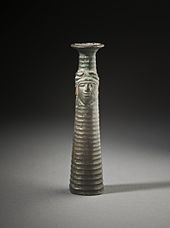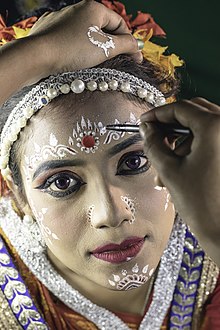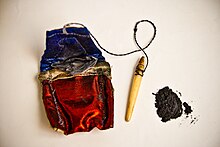Kohl (cosmetics)


Kohl is an eye cosmetic, traditionally made by crushing stibnite for use similar to that of charcoal in mascara.
It is widely used throughout the world, typically as eyeliner to contour or darken the eyelids. The content of kohl and various ways to prepare it differ based on tradition and country. Several studies have questioned the safety of kohl due to the dangers of lead poisoning. Importing kohl into the United States is banned.
Etymology

The Arabic name كحل kuḥl formed the Arabic root k-ḥ-l, "to apply kohl". Transliteration variants of Arabic dialectal pronunciation include kohl or kuhl. The Arabic word cognates with Syriac-Aramaic word כוחלא/ܟܘܚܠܐ kuḥla. Both words derived from Akkadian 𒎎𒋆𒁉𒍣𒁕 guẖlu(m) meaning stibnite.
The English word alcohol is a loan of the Arabic word (via Middle Latin and French; originally in the sense "powder of antimony". The modern meaning is from the 18th century).
Middle East and North Africa

Kohl has been worn traditionally since the Naqada III era (c. 3100 BCE) by Egyptians of all social classes, originally as protection against eye ailments.[1][2] There was also a belief that darkening around the eyes would protect one from the harsh rays of the sun.[3]

Galena eye paint (later termed Kohl in Arabic from the Akkadian word for the cosmetic) was widely applied in ancient Egypt. Upper eyelids were painted black and lower ones were colored green, as depicted in ancient texts that describe the use of both black galena and green malachite. Ancient graves from the prehistoric Tasian culture point to the early application of galena in Egypt, a custom stretching from as old as the Badarian culture through to the Greco-Roman era. Although found locally, both black galena and green malachite were also imported from nearby regions in Western Asia, Coptos, and the Land of Punt.[4]
The 18th Dynasty female Pharaoh Hatshepsut would also grind charred frankincense into kohl eyeliner. This is the first recorded use of the resin.[5] The frankincense itself had originally been obtained during an expedition to the ancient Land of Punt in this New Kingdom dynasty (c. 1500 BCE).[6] Cosmetic ingredients such as cinnamon bark and other spice components – used for fragrances – alongside copper kohl sticks were exported from the towns of Pomparippu and Kadiramalai-Kandarodai in Tamraparni (ancient Sri Lanka) to ancient Egypt.[7][8][9][10]
Additionally, the pioneering Muslim scholar ibn Abi Shaybah described in a legal compilation how to apply kohl to the eye, as narrated by earlier authorities.[11]
Berber and Semitic-speaking women in North Africa and the Middle East, respectively, also apply kohl to their faces. A vertical line is drawn from the bottom lip to the chin and along the bridge of the nose. Originally the line from the bottom lip to the chin showed whether a woman was married or not. This form of using kohl on the face originated from the Arabian Peninsula, and was introduced in the seventh century to North Africa.[12]
Kohl has also been used in Yemen as a cosmetic for a long time. In addition, mothers would apply kohl to their infants' eyes soon after birth. Some did this to "strengthen the child's eyes", and others believed it could prevent the child from being cursed by the evil eye.[13]
Horn of Africa

Usage of kohl eye paint in the Horn of Africa dates to the ancient Kingdom of Punt.[4] Somali, Djiboutian, Ethiopian, and Eritrean women have long applied kohl (kuul) for cosmetic purposes, as well as to cleanse the eyes, lengthen eyelashes, and to protect the eyes from the sun's rays.[14][15]
West Africa
Kohl is also applied in by many peoples parts of West Africa, including the Fulani, the Hausa people, the Tuareg, and the Yoruba.[16][17][18] In addition, it is utilized by Muslim inhabitants of the Sahel and Sahara regions. Kohl is used by both sexes, and by people of all ages during weddings, festivals, and outings.[citation needed]
For women, kohl or black-henna is applied to the face as well in a similar manner as that practiced by communities in North Africa.
South Asia

In many parts of India, kohl is referred to as kājal. In Southern India (Karnataka in particular), local tradition considers it to be a traditional remedy.
Some Indian Ayurvedic (i.e., ancient Indian herbal medicine) manufacturing companies add camphor and other medicinal herbs that are meant for eye health.

In Punjabi culture, kājal is a traditional ceremonial dye predominantly worn by men around their eyes on special occasions. It is usually applied by the wife or the mother.
Some people[who?] apply dots of kājal to ward off bad omens & the evil eye (nazar).

Kohl is also an integral part of Bharatanatyam and Odissi dances in India. The dancers apply kohl heavily to their eyes so as to draw attention to their eye gestures and movement.
Preparation
Preparation of homemade kohl holds importance to many people across the world. It traditionally involves burning sandalwood paste with cloth wicks and castor oil, collecting the soot, and adding fat to the soot.
The ingredients used in the homemade preparation of kohl are believed by local peoples to have medicinal properties. They are still used in Indian therapies like ayurveda and Siddha medicines.
Health concerns
The content of kohl and the recipes to prepare it vary greatly. In North Africa and the Middle East, homemade kohl is often made by grinding galena (lead sulfide). Western manufacturers use amorphous carbon or organic charcoal instead of lead. Plant oils and the soot from various nuts, seeds, and gum resins are often added to the carbon powder. The non-lead products are considered[by whom?] to be of inferior quality to the older, traditional varieties, and so there has been an increase in the use of handmade, lead-based kohl.

For decades, various conflicting reports in the literature have been published relating to kohl application to eyes being responsible for causing higher blood lead concentration, which may cause lead poisoning. At the same time, a number of research studies and reports have also been published refuting any such links to increased blood lead levels upon kohl application.[19]
A group of researchers in China tried to find some scientific basis of this claimed property of lead sulfide (galena) relating to absorption of sun rays when applied into the eyes in the form of kohl.[20] The authors reported the ultraviolet (UV) absorption spectra of a thin film of lead sulfide prepared on an indium tin oxide (ITO) substrate. The spectra showed that thin films of lead sulfide had higher absorption and lower transmittance in the UV light band, which further increases with increased deposition voltage.
The drive to eliminate lead from kohl was sparked by studies in the early 1990s of preparations of kohl that found high levels of contaminants, including lead.[21][22][23] Lead levels in commercial kohl preparations were as high as 84%. Kohl samples from Oman and Cairo, analyzed using X-ray powder diffraction and scanning electron microscopy, were found to contain galena.[13][21] One decade later, a study of kohl manufactured in Egypt and India found that a third of the samples studied contained lead, while the remaining two-thirds contained amorphous carbon,[13] zincite,[13][21] cuprite,[13] goethite,[13] elemental silicon[13] or talc,[13] hematite, minium,[21] and organic compounds.[13]
Lead-contaminated kohl use has been linked to increased levels of lead in the bloodstream,[24][25][26][27] putting its users at risk of lead poisoning (also called lead intoxication). Complications of lead poisoning include anemia, growth retardation, low IQ, convulsions, and, in severe cases, death. Anemia from lead poisoning is of special concern in Middle Eastern and South Asian countries where other forms of anemia are prevalent, including iron deficiency anemia (from malnutrition) and hemoglobinopathy (sickle cell anemia, thalassemia).

These banned products are different from lead-free cosmetics that use the term "kohl" only to describe its shade or color, rather than its actual ingredients. Some modern eye cosmetics are marketed as "kohl", but are prepared differently and in accordance with relevant health standards.
Eye cosmetics such as surma are recognized as one of the important sources of lead exposure in Pakistan. As adverse health effects of heavy metals are a public health concern, where especially lead may cause negative health impacts to human fetal and infantile development, a study in Pakistan of pregnant women's nails in 2016, showed 13 nail samples out of 84 analyzed contained lead concentrations exceeding the 13.6 μg/g found in a fatal case of lead poisoning. (The possibility of an external contamination was excluded.) The observations showed that lead-containing surma consists of fine particles of galena (ore of lead sulfide) in a respirable dust range (less than 10 μm), and relative in vitro bioavailability of lead in the surma was determined as 5.2%. Thus, lead-containing surma consists of inhalable and bioavailable particles, and it contributes to an increased risk of lead exposure.[28]
"Blue" kohl is a dark-bluish black pigment composed of lead-based compounds as well as a compound of antimony. The lead-based compounds in kohl are galena (PbS) – dark grey and gloss, laurionite (PbCl(OH)) – white, phosgenite (PbCl)2CO3), and cerussite (PbCO3) – blue. The antimony-based compound in kohl is stibnite (Sb2S3) – blue.
In January 2010, French researchers reported that the particular heavy eye makeup that ancient Egyptians wore may have had medical benefits. At submicromolar concentrations, the specially-made lead compounds can elicit overproduction of nitric oxide (NO), which in turn can trigger an enhancement of the immune response.[29][30]
The ancient Egyptians, documented in the Ebers Papyrus (c. 1550 BCE), discuss these compounds within kohl as protective for the eyes. Indeed, kohl was used as both an cosmetic eyeliner and a medicinal. There are a number of endemic ocular diseases in the Nile region including trachoma – which is caused by a chlamydial bacterium and can cause corneal scarring – and conjunctival cicatricial disease, with resulting visual loss. Kohl was used not only as a cosmetic but also as a medicinal collyrium (from Greek kollurion). Two of kohl's lead compounds – the lead chlorides laurionite and phosgenite – were not natural to the Nile valley. It is believed they were intentionally synthesized by the ancient Egyptians for this purpose. The widespread use of kohl across the Mediterranean and the Middle East attests to its ability to protect the eye from infectious disease and as well as being used as a cosmetic.[31][32]
Legal status
In the United States, kohl is not on the list of color additives approved by the Food and Drug Administration, which considers kohl unsafe for use due to its potential lead content. It is illegal to import into, or sell in, the United States.[33] Kohl is considered unsafe partly due to risk of lead exposure.
See also
References
References
- ^ "Ophthalmology of the Pharaohs: Antimicrobial Kohl Eyeliner in Ancient Egypt". Discover. Retrieved 2021-12-05.
- ^ Mohta, Anup (2010). "Kajal (Kohl): A dangerous cosmetic". Oman Journal of Ophthalmology. 3 (2): 100–101. doi:10.4103/0974-620X.64242. ISSN 0974-620X. PMC 3003848. PMID 21217909.
- ^ Hardy, Andrew D.; Walton, Richard I.; Myers, Kathryn A.; Vaishnav, Ragini (March 2006). "Availability and chemical composition of traditional eye cosmetics ('kohls') used in the United Arab Emirates of Dubai, Sharjah, Ajman, Umm Al-Quwain, Ras Al-Khaimah, and Fujairah". Journal of Cosmetic Science. 57 (2): 107–125. ISSN 1525-7886. PMID 16688375.
- ^ a b Studies in Ancient Technology, Volume III, Brill Archive, p.18.
- ^ Isaac, Michael (2004). A Historical Atlas of Oman. Rosen. p. 14. ISBN 978-0823945009. Retrieved 5 September 2014.
- ^ Martin Watt, Wanda Sellar (2012). Frankincense & Myrrh: Through the Ages, and a complete guide to their use in herbalism and aromatherapy today. Random House. p. 24. ISBN 978-1446490778. Retrieved 11 November 2016.
- ^ Uragoda, C. G. (1987). A history of medicine in Sri Lanka from the earliest times to 1948. Sri Lanka Medical Association. p. 8. Retrieved 22 June 2019.
- ^ Intirapālā, Kārttikēcu (2005). The evolution of an ethnic identity: the Tamils in Sri Lanka c. 300 BCE to c. 1200 CE. M.V. Publications for the South Asian Studies Centre, Sydney. p. 63. ISBN 9780646425467.
- ^ International Journal of Dravidian Linguistics. Department of Linguistics, University of Kerala. 2009. p. 62.
- ^ Brand, Chad; Mitchell, Eric; Staff, Holman Reference Editorial (2015). Holman Illustrated Bible Dictionary. B&H Publishing Group. p. 351. ISBN 9780805499353. Retrieved 22 June 2019.
- ^ Swain, Simon, ed. (2007). Seeing the Face, Seeing the Soul: Polemon's Physiognomy from Classical Antiquity to Medieval Islam. Oxford University Press. p. 277. ISBN 978-0199291533.
- ^ Many Mirrors: Body Image and Social Relations. Nicole Landry Sault.
- ^ a b c d e f g h i Hardy A, Walton R, Vaishnav R (February 2004). "Composition of eye cosmetics (kohls) used in Cairo". International Journal of Environmental Health Research. 14 (1): 83–91. Bibcode:2004IJEHR..14...83H. doi:10.1080/09603120310001633859. PMID 14660121.
- ^ Katheryne S. Loughran, Somalia in word and image, (Foundation for Cross Cultural Understanding: 1986), p.166.
- ^ Sergew Hable Selassie, Ancient and medieval Ethiopian history to 1270, (Printed by United Printers: 1972), p.26.
- ^ Nasidi, A., Karwowski, M.P., Woolf, A.D., Kellogg, M.D., Law, T.C., Sucosky, M.S., Glass-Pue, R.M., Brown, M.J., & Behbod, B. (2012). "Infant lead poisoning associated with use of tiro, an eye cosmetic from Nigeria--Boston, Massachusetts, 2011". MMWR. Morbidity and mortality weekly report, 61 30, 574-6 .
- ^ Bascom, W. R. (1949). Literary style in Yoruba riddles. The Journal of American Folklore, 62(243), 1-16.
- ^ Alan Donovan, My journey through African Heritage, (Kenway Publications: 2004), p.62.
- ^ Mahmood ZA, Zoha SM, Usmanghani K, Hasan MM, Ali O, Jahan S, Saeed A, Zaihd R, Zubair M, Pak (January 2009). "Kohl (surma): retrospect and prospect". Journal of Pharmaceutical Sciences. 22 (1): 107–122. PMID 19168431.
- ^ Li-Yun C, Wen H, Jian-Feng H and Jian-Peng W (2008). "Influence of deposition voltage on properties of lead sulfide thin film". American Ceramic Society Bulletin, 87(6): 9101–9104
- ^ a b c d Hardy AD, Vaishnav R, Al-Kharusi SS, Sutherland HH, Worthing MA (April 1998). "Composition of eye cosmetics (kohls) used in Oman". Journal of Ethnopharmacology. 60 (3): 223–34. doi:10.1016/S0378-8741(97)00156-6. PMID 9613836.
- ^ al-Hazzaa SA, Krahn PM (1995). "Kohl: a hazardous eyeliner". International Ophthalmology. 19 (2): 83–88. doi:10.1007/BF00133177. PMID 8586501. S2CID 33603176.
- ^ Parry C, Eaton J (August 1991). "Kohl: a lead-hazardous eye makeup from the Third World to the First World". Environmental Health Perspectives (94): 121–123.
- ^ Alkhawajah AM (October 1992). "Alkohl use in Saudi Arabia: Extent of use and possible lead toxicity". Tropical Geographical Medicine. 44 (4): 373–377. PMID 1295151.
- ^ Al-Saleh I, Nester M, DeVol E, Shinwari N, Al-Shahria S (April–June 1999). "Determinants of blood lead levels in Saudi Arabian schoolgirls". International Journal of Occupational and Environmental Health. 5 (2): 107–114. doi:10.1179/oeh.1999.5.2.107. PMID 10330510.
- ^ Nir A, Tamir A, Nelnik N, Iancu TC (July 1992). "Is eye cosmetic a source of lead poisoning?". Israel Journal of Medical Science. 28 (7): 417–421. PMID 1506164.
- ^ Rahbar MH, White F, Agboatwalla M, Hozhbari S, Luby S (2002). "Factors associated with elevated blood lead concentrations in children in Karachi, Pakistan". Bulletin of the World Health Organization. 80 (10): 769–775. PMC 2567650. PMID 12471396.
- ^ Ikegami, Akihiko; Takagi, Mai; Fatmi, Zafar; Kobayashi, Yayoi; Ohtsu, Mayumi; Cui, Xiaoyi; Mise, Nathan; Mizuno, Atsuko; Sahito, Ambreen (2016-11-01). "External lead contamination of women's nails by surma in Pakistan: Is the biomarker reliable?". Environmental Pollution. 218 (Supplement C): 723–727. Bibcode:2016EPoll.218..723I. doi:10.1016/j.envpol.2016.07.068. PMID 27554978.
- ^ Tapsoba I, Arbault S, Walter P, Amatore C (January 2010). "Finding Out Egyptian Gods' Secret Using Analytical Chemistry: Biomedical Properties of Egyptian Black Makeup Revealed by Amperometry at Single Cells". Analytical Chemistry. 82 (2): 457–460. doi:10.1021/ac902348g. PMID 20030333.
- ^ National Geographic "Cleopatra's eye makeup Warded Off Infections?"
- ^ Kreston, Rebecca (April 20, 2012). "Ophthalmology of the Pharaohs: Antimicrobial Kohl Eyeliner in Ancient Egypt". Body Horrors. Discover.
- ^ Tapsoba, Issa; Arbault, Stéphane; Walter, Philippe; Amatore, Christian (2010). "Finding Out Egyptian Gods' Secret Using Analytical Chemistry: Biomedical Properties of Egyptian Black Makeup Revealed by Amperometry at Single Cells". Analytical Chemistry. 82 (2): 457–460. doi:10.1021/ac902348g. PMID 20030333.
- ^ "Kohl, Kajal, Al-Kahal, Surma, Tiro, Tozali, or Kwalli: By Any Name, Beware of Lead Poisoning". Food and Drug Administration. Retrieved 2017-10-26.
Bibliography
- Al-Ashban RM, Aslam M, Shah AH., Public Health. 2004 Jun;118(4):292–8. "Kohl (surma): a toxic traditional eye cosmetic study in Saudi Arabia."
- Abdullah MA., J Trop Med Hyg. 1984 Apr;87(2):67–70. "Lead poisoning among children in Saudi Arabia."
- Hardy AD, Walton RI, Myers KA, Vaishnav R., J Cosmet Sci. 2006 Mar–Apr;57(2):107–25. "Availability and chemical composition of traditional eye cosmetics ('kohls') used in the United Arab Emirates of Dubai, Sharjah, Ajman, Umm Al-Quwain, Ras Al-Khaimah, and Fujairah."
- Shaltout A, Yaish SA, Fernando N., Ann Trop Paediatr. 1981 Dec;1(4):209–15. "Lead encephalopathy in infants in Kuwait. A study of 20 infants with particular reference to clinical presentation and source of lead poisoning."
External links
- Egyptian: Kohl pot, Black steatite. Click on picture.
- Egyptian: Bone kohl pot. Figurine design. Click on picture.
- Kohl (CopperWiki)
